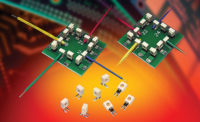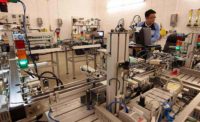Once upon a time, automated guided vehicles (AGVs) were only found in warehouses, automotive assembly plants and other operations with large amounts of floor space. But, that’s starting to change. Recent advancements have made the machines more appealing to small- and mid-sized manufacturers in a wide variety of industries.
Companies are investing in AGVs to improve plant-floor efficiency and reduce operating cost. As the flexible technology becomes more affordable and easier to use on assembly lines, many manufacturers are deploying driverless carts, robotic parts bins and autonomous tuggers.
Manufacturing engineers have more options available than ever. In fact, at last month’s ProMat trade show in Chicago, exhibitors unveiled several new types of machines.
“The market is ultra competitive these days,” says Keith Soderlund, vice president of sales at Creform Corp. “Lots of new competitors are driving prices down and capability up.”
One of the newest players is Hi-Tech Robotic Systemz Ltd., the largest mobile robotics company in India. It made its North American debut at the ProMat show. The company has installed more than 100 AGVs in the last three years for applications such as engine assembly, mobile assembly stations and parts kitting.
According to the MHIA’s automated guided vehicle systems group, an AGV consists of one or more computer-controlled, wheel-based load carriers. The battery-powered devices operate without a driver and come in a wide variety of sizes, shapes and styles.
Engineers can choose between tuggers that pull a string of carts or trailers in a train; unit load carriers that move subassemblies and work-in-process from one assembly station to another; forked pallet trucks that interface with pickup and drop off points on the plant floor; and automated guided carts (AGCs) that are smaller, cheaper and easier to install than traditional AGVs. AGCs are popular for applications where lighter loads and flexibility are required.
AGVs and AGCs have defined paths or areas within which or over which they can navigate. Navigation is achieved by several means, such as following a path defined by surface-mounted magnetic tape or optical strips. Laser guidance, GPS and vision systems are also popular.
Another option is to use inductive power transfer. It eliminates the need for batteries and provides a constantly available power source. However, data and communication cables have to be laid into shallow channels on the plant floor.
“We’re seeing a lot of interest in alternate technologies for navigation,” says Rod Emery, PE, vice president of assembly and integration systems at RedViking Engineering. “A battery-free system does not put any limitation on your duty cycle, which allows for a very flexible assembly line.
“You don’t need to have an elaborate strategy for battery charging and maintenance,” adds Emery. “Payload capacity is not a problem, and battery life and power density are not issues.”
RedViking has installed inductive power transfer AGV systems at Caterpillar and other manufacturers.
Today’s AGVs are more advanced than what was available a decade ago. The machines are now faster, safer, easier to program, more precise and less expensive.
Improved Technology
“AGV technology is advancing rapidly,” says Mark Longacre, marketing manager at JBT Corp. “[We] are using more advanced navigation systems and in some cases multiple navigation systems on one AGV.
“[Some machines] now use natural environment navigation where the AGV compares actual conditions with a baseline map to safely move through the facility,” Longacre points out. “In complex facilities, AGVs switch seamlessly between different navigation technologies so that optimum performance can be obtained in all areas.”
“Driven by faster hardware and improved software, AGVs have become very user friendly with graphical interfaces,” adds David Spangler, director of Frog AGV Systems Inc., an Oceaneering International Co. “This makes them very comprehensible and easy to use. Free-ranging navigation systems, where the routes are captured in software, make path changes easy.”
Most AGV developments in recent years have focused on software, safety systems and battery technology. For instance, vehicle and supervisory software has evolved.
“Faster and more reliable Wi-Fi networks have enabled improvements in intelligence of the management systems that are continuously supervising and directing AGVs,” says Spangler. “Algorithms for transport assignments, traffic management and throughput are also much more efficient.
“This results in AGVs having less time-loss caused by bad task assignments or traffic jams,” adds Spangler. “At the same time, the free-ranging navigation and free-programmability of AGV-routes are much more user-friendly and more effective.”
Today, many AGVs use off-the-shelf components, such as Omron laser scanners and Sick vision sensors. “Most manufacturers no longer design their own drives, PLCs and safety systems,” says Tom Kaminski, CEO of Egemin Automation Inc. “Why reinvent the wheel when we can use proven technology?
“We are always watching the auto industry,” adds Kaminski. “For instance, we’re real interested in the self-driving technology being developed by companies such as Google and Volvo.”
Laser scanners have evolved to include better features and have been reduced in size. They can also be more easily adapted to specific AGV functions and respective driving areas.
“Recent improvements in software and safety sensing have resulted in other advantages to AGV systems,” says Spangler. “For instance, with navigation becoming more accurate, AGVs are now able to safely drive much faster.”
Energy storage technology for AGVs has also made a big leap forward in recent years. Batteries are now smaller and lighter, have faster recharging cycles and have a much longer lifespan.
“These improvements result in AGVs spending less time charging and more time driving,” says Spangler. “As these batteries are becoming more popular across various markets, their costs are also coming down considerably.”
“Most AGV suppliers now offer AC motors in lieu of the former DC configurations that required maintenance on brushes and commutators,” adds Chuck Russell, vice president of sales at Transbotics Corp. “Assembly lines, like many applications, are highly repetitive in nature, so ensuring the components are rated for the intended cycle duty is key.”
Assembly Applications
Traditionally, AGVs have been widely used in warehouses and distribution centers. But, they are becoming more popular for assembly applications. And, automated vehicles are no longer an option just for big manufacturers that operate 24/7. The technology is now within the reach of small- and mid-sized companies.
“We’re seeing more use on assembly lines themselves, as well as systems that support assembly lines,” says Soderlund. “Production numbers are up; leaving routine material movement to AGVs is one way to free people up to [focus on] value-adding jobs.”
Automated vehicles are commonly used to deliver part and subassemblies to the main assembly line. And, thanks to lean manufacturing initiatives, kitting of parts for mixed product assembly is becoming increasingly popular.
“When this is done, most of the inventory is moved off the line and to a supermarket kitting area,” explains Soderlund. “AGVs deliver just what’s needed when and where needed. This is one type of system where it’s extremely beneficial to have a small AGV for maneuvering and delivering to tight spaces.”
“There’s been a big focus on using AGVs for assembly line applications,” adds RedViking’s Emery. “With conveyors, reconfiguring an assembly line is very labor-intensive. Manufacturers no longer want to have all the pits, pedestals, trenches and other monuments that come with a traditional chain-based conveyor system.
“We’re seeing AGVs used for more nonautomotive assembly applications, such as air compressors, appliances and generators,” Emery points out. “There’s also been a great deal of interest from aerospace manufacturers.
“The aerospace industry wants to get away from ‘roots and vines,’ which refers to the continual process of removing and reattaching air lines and electrical cables,” explains Emery. He says mounting air, power and data cables directly to AGVs can reduce trip hazards on the plant floor.
“There is constant pressure on manufacturing costs today, especially as more [production] returns to the United States from formerly low-cost regions,” notes Spangler. “With small- and mid-sized manufacturers, this cost pressure can be enormous.
“That’s why more companies are eager to [adopt] AGV systems,” Spangler points out. “These systems operate safely on a 24/7 basis and have a lower total cost than manned material handling systems. Automated vehicles have a fast implementation time and don’t take up permanent space in a plant.”
Increased Flexibility
“We are seeing an enormous increase in assembly line applications because of the flexibility that AGVs and AGCs provide,” claims Sarah Carlson, marketing director at Jervis B. Webb Co., a division of Daifuku North America Holding Co. “AGVs and AGCs are being used by all sizes of manufacturers. We have installed one-vehicle systems all the way up to several hundred vehicles.
“In [our] patented synchronized system, AGVs travel at an equal distance continuously along a line or path,” adds Carlson. “This continuous motion allows AGVs to be used in assembly operations, replacing traditional conveyor systems.
“AGV systems offer increased flexibility because the path can be quickly installed and modified to meet changing production needs,” Carlson points out. “They are also scalable, allowing capacity
to be easily increased or decreased by adding or removing vehicles.”
AGCs, a scaled-down version of traditional AGVs, are popular for assembly line applications, because they excel at handling lighter loads and allow trailers to be towed from underneath, a process commonly referred to as “tunneling.”
Jervis B. Webb has installed more than 3,000 AGCs in factories around the world. Its Smart Carts are available in two models. The 300TT SmartCart is capable of towing up to 4,000 pounds and carrying up to 2,400 pounds. However, the Model 100TT is more popular. It can handle loads of up to 1,950 pounds.
Magna International Inc. uses 36 SmartCarts at its Toledo, OH, plant to assemble front and rear bumper fascias and front-end modules for the Jeep Cherokee and Wrangler. Before the system was installed two years ago, Magna was using a rotating 12-position carousel, which made material delivery difficult. “It took up too much floor space and could not easily accommodate future growth or changes,” Carlson points out.
With the carousel, Magna would have needed 30 stations to maintain its current throughput, which would take up the entire 179,000-square-foot building. “SmartCarts gave Magna the flexibility it needed to reduce floor space,” says Carlson.
SmartCarts can also be equipped with scissor lifts that address ergonomic issues and concerns. For instance, at John Deere’s lawn and garden tractor assembly plant in Horicon, WI, SmartCarts adjust to various heights at workstations depending on what tasks need to be performed.
A gap in the market exists between AGVs and AGCs. At last month’s ProMat show, several suppliers unveiled new products to address that issue.
Egemin featured a machine called E’gv Compact. “It’s a low-cost vehicle that’s less complex than an AGV and more flexible than an AGC,” says Kaminski.
The product will be priced in the $50,000 to $75,000 price range, depending on whether the system uses tuggers, forklifts or other material handling options. By comparison, AGCs typically run anywhere from $10,000 to $20,000, while the average cost of AGVs is $100,000 to $150,000.
JBT Corp. unveiled a similar product at ProMat called the JayBoT. “It is designed for mid-sized manufacturers and warehouses where AGCs don’t offer enough functionality and where traditional AGVs are too expensive,” says Longacre. “The [machine offers manufacturers] an entry-level AGV solution for routine movement of material. The solution costs much less and can be installed much more quickly than a traditional AGV system.
“Unlike many AGV systems currently on the market, the intelligence components are housed in the unit itself, eliminating the need for a system manager,” adds Longacre. “The JayBoT solution is also completely scalable and can range from completely decentralized (for simple A to B movements) to fully centralized (for highly optimized fleets).”
To learn more about AGV technology, read the following articles:










